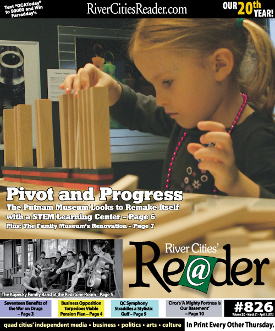 This past weekend, we brought our daughter to Davenport's Putnam Museum and did the full tour. We saw Flight of the Butterflies 3D on the Giant Screen, walked through the new Bodies Revealed show, and saw all the cultural-, regional-, and natural-history displays that visitors have known for decades, from the mummies to the Asian artifacts to Bix's cornet.
This past weekend, we brought our daughter to Davenport's Putnam Museum and did the full tour. We saw Flight of the Butterflies 3D on the Giant Screen, walked through the new Bodies Revealed show, and saw all the cultural-, regional-, and natural-history displays that visitors have known for decades, from the mummies to the Asian artifacts to Bix's cornet.
But what kept Emily's attention was the Spark Learning Lab, a modest career-themed room with the goal of preventing high-school drop-outs.
Our daughter is five and in no danger yet of dropping out of any school - or pursuing any career beyond princess-ing. And the Spark Learning Lab is geared toward fifth- and sixth-graders. But she loved the lab's drawing program with the dual touch screens (one on the computer and one where the picture was being projected), the construction-plank set (which she's playing with on this issue's cover), and the feature that allows visitors to build tube structures and - with the help of a blower - either launch table-tennis balls or keep them aloft.
One station in the room lets visitors connect batteries to simple electrical devices, and another shows how structures they build with Lincoln Logs or those aforementioned planks might fare in an earthquake. The "concentration station" fosters communications skills, as one person describes a block structure and a partner tries to build its twin using verbal instructions alone.
If you want to see where the Putnam is headed, you can look at the conceptual drawings - posted in several locations - of its planned STEM learning center. The $1.5-million project is currently in the fundraising phase, and the museum expects to open it in June 2014. Putnam President and CEO Kim Findlay said adding the STEM center to the Putnam now is "the right time and the right thing for the community and the museum."
But you'll get a hands-on sense of the Putnam's direction in the Spark Learning Lab. Larger-scale hints are available in the interactive components of the current Destination: Space exhibit, with its compressed-air tennis-ball launcher, and a bicycle wheel and rotating platform demonstrating angular momentum.
Implicitly and explicitly, all of these draw a line from playful exploration to science to careers, and that's what the STEM center will do on a much grander level. It's an attempt to transform the nearly-century-and-a-half-old Putnam from "nice to necessary," to use a phrase that's common in the museum field these days.









